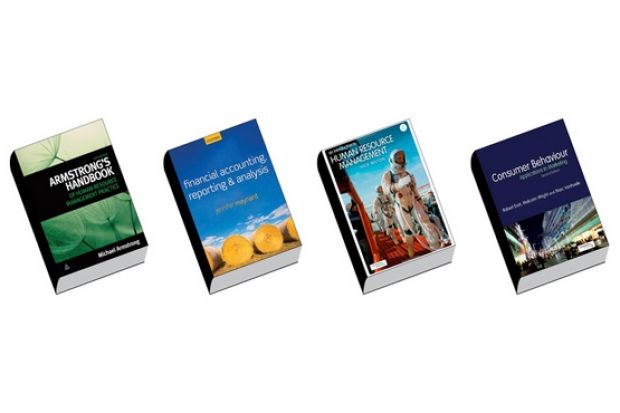One of higher education’s biggest “success” stories in the past 50 years has been the growth of business and management studies. Since the early 1960s, the number of UK business schools and management departments offering higher education courses has increased from fewer than 20 to more than 500, the undergraduate and postgraduate student cohort has ballooned from under 10,000 to more than 300,000, and the number of teaching staff has grown from a few hundred to more than 15,000. Overall, a very big captive market.
At the same time, the number of textbooks and general titles in this field has grown (from 7,000 new titles in 2002 to more than 12,000 in 2011, according to Bowker BML). Expansion has brought greater competition; the average amount of money individual students spend on books has declined as the number of titles in print has grown. Accordingly, publishers have sought to make core texts longer, bigger, heavier and glossier. It is ironic that when the most recent real business success is Summly – an app that cuts down the length of articles for a TLDR (too long; didn’t read) world – the strength and weight of the arguments in business and management textbooks seem to be expressed in column centimetres and kilograms rather than in the density and impact of their prose.
In the early days of university-based business and management studies, textbooks synthesised information from difficult-to-access sources. Today, in a world of digital information overload, textbooks have been relatively slow to respond to the rise of the internet and wireless communication tools. Indeed, when authors and publishers acknowledge new (and not so new) media, it is usually via supplementary online resources, rather than the direct replacement of text with online audio and video. That is not to say that these alternative forms of communication are not available; online journals, virtual learning environments, social media and massive open online courses have been used for years. But these “free” (to many users) and wholly digital media are rarely reviewed or considered in academic journals and magazines alongside more traditional (and saleable) print textbooks.
This may change, but probably not by textbooks going online. The rise of tablet PCs, smartphones and e-readers has increased the sale of digital fiction but there are still few business and management e-textbooks. Publishers evidently fear that the widespread availability of e-textbooks – and the potential for unauthorised duplication – might erode the sales of less easily copied print titles.
To pay for the increased size and complexity of new business and management textbooks, prices have risen steadily. The list prices of the texts noted here range from £17 to £135, averaging £38 for a paperback. This, coupled with the rise in tuition fees and living costs in the past two years, has sped the decline in sales to students if not to libraries.
Just as the format of textbooks has been slow to change, so too has their coverage and content. Over the past year, close to two-thirds of new titles were in their second, third or fourth editions and several have reached double figures. For example, Armstrong’s Handbook of Human Resource Management Practice is now in its 12th edition and Contemporary Marketing (Boone and Kurtz) is in its 16th.
But it is not just the old stalwarts that provide signs of continuity. Among the 70 first editions published recently, there are many titles whose publishers clearly hope they will become required reading on first- and second-year undergraduate modules and large initial courses on postgraduate programmes. Accordingly, they generally cover much the same ground as their established competitors while also striving to demonstrate differences in content, format and style. A good example of this new breed of challenger is Management Accounting (Burns et al), which addresses the familiar territory of costing, budgeting, pricing, investment and performance management, but does so more engagingly and accessibly than many market leaders. Similarly, Financial Accounting, Reporting & Analysis (Maynard) covers the basics of financial reporting and income statements, but with up-to-date information on the legal regulation of these activities in the UK.
Other noteworthy new titles aimed at core courses include An Introduction to Human Resource Management (Wilton) and Essentials of Marketing (Baines et al). Both embrace new media more extensively than many. Their case studies illustrate key concepts and issues, and printed material is supported by online resource centres offering video footage, podcasts, weblinks, multiple-choice questions, PowerPoint slides, essay questions and tutorials.
Specialist texts focused on elective and optional modules are typically smaller and less complex, without necessarily being less effective than larger titles designed for core courses. For example, Consumer Behaviour: Applications in Marketing (East et al) and Principles of Business Forecasting (Ord and Fildes) provide data files and guides to assist in the completion of computer-based tasks covering analytical methods. After reading those two books, I’d speculate that if the techniques they deal with were applied to a study of the business and management textbook industry, it would likely demonstrate that while the most successful students buy and use textbooks more than their less successful colleagues, this correlation may not be highly causal.
More importantly, if current trends continue, student textbook purchase (and possibly use) will shrink significantly. How we should address this is something for publishers, authors and lecturers to think about. But it is probably not worth writing a textbook about it.
Tap and scroll down for links to all Business and management textbooks
Or view PDF below
Register to continue
Why register?
- Registration is free and only takes a moment
- Once registered, you can read 3 articles a month
- Sign up for our newsletter
Subscribe
Or subscribe for unlimited access to:
- Unlimited access to news, views, insights & reviews
- Digital editions
- Digital access to THE’s university and college rankings analysis
Already registered or a current subscriber? Login
